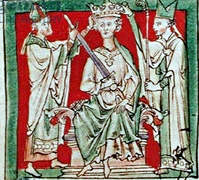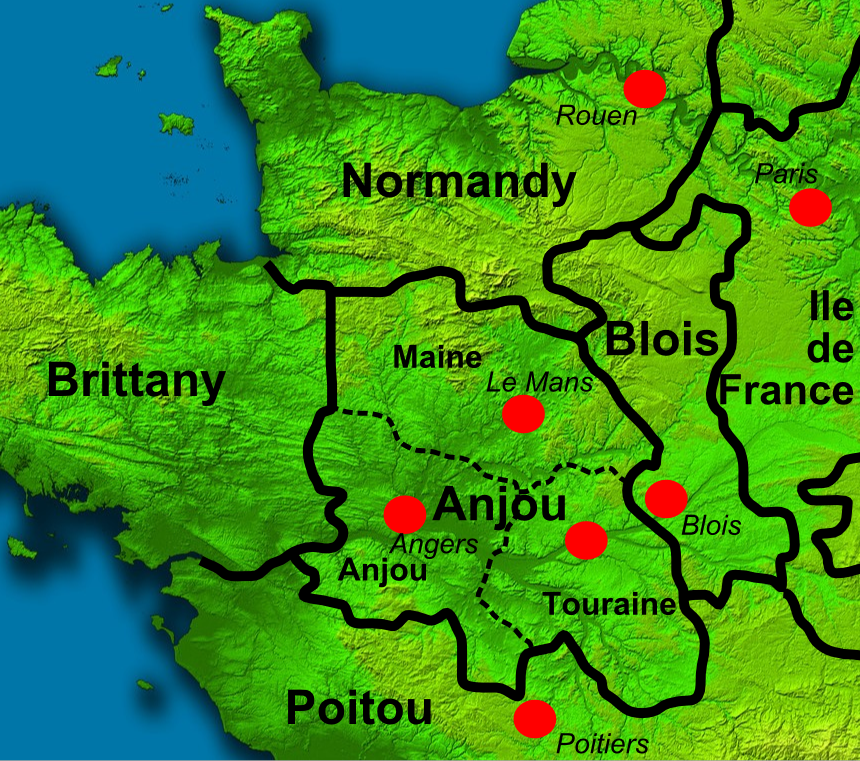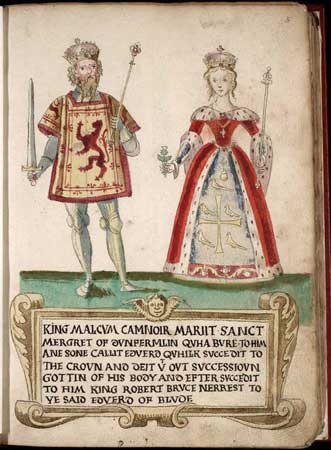|
Matilda Of Boulogne
Matilda I of Boulogne ( – 3 May 1152) was Countess of Boulogne in her own right from 1125 and Queen of England from the accession of her husband, King Stephen, in 1135 until her death in 1152. She supported Stephen in his struggle for the English throne against their mutual cousin Empress Matilda. She played an unusually active role for a woman of the period when her husband was captured, and proved herself an effective general who managed to force the Empress to release Stephen. Under the agreement that settled the civil war, the Queen's children did not inherit the English throne but her three surviving children ruled Boulogne in turn as Eustace IV, William I, and Marie I. Background Matilda was born in Boulogne, France. Her father was Count Eustace III of Boulogne. Her mother, Mary, was the daughter of King Malcolm III of Scotland and Saint Margaret of Scotland. Through her maternal grandmother, Matilda was descended from the Anglo-Saxon kings of England. Coun ... [...More Info...] [...Related Items...] OR: [Wikipedia] [Google] [Baidu] |
Queen Consort Of England
The English royal consorts listed here were the spouses of the reigning monarchs of the Kingdom of England, excluding joint rulers William III of England, William III and Mary II who reigned together in the 17th century. Most of the consorts were women, and enjoyed titles and honours pertaining to a queen consort; some few were men, whose titles were not consistent, depending upon the circumstances of their spouses' reigns. The Kingdom of England merged with the Kingdom of Scotland in 1707, to form the Kingdom of Great Britain. There have thus been no consorts of England since that date. Athelstan, Edward the Martyr, Harold Harefoot(?), Harthacnut, William II of England, William II, Edward V, Edward VI and Elizabeth I are all excluded from this list because they never married. House of Wessex, 886–1013 House of Denmark, 1013–1014 House of Wessex (restored, first time), 1014–1016 House of Denmark (restored), 1016–1042 House of Wessex (restored, second time), 10 ... [...More Info...] [...Related Items...] OR: [Wikipedia] [Google] [Baidu] |
The Anarchy
The Anarchy was a civil war in England and Duchy of Normandy, Normandy between 1138 and 1153, which resulted in a widespread breakdown in law and order. The conflict was a war of succession precipitated by the accidental death of William Adelin (the only legitimate son of Henry I of England, Henry I), who drowned in the White Ship disaster, ''White Ship'' disaster of 1120. Henry sought to be succeeded by his daughter, known as Empress Matilda, but was only partially successful in convincing the nobility to support her. On Henry's death in 1135, his nephew Stephen of Blois seized the throne with the help of Stephen's brother Henry of Blois, who was the bishop of Winchester. He was crowned as Stephen, King of England, King Stephen, and his early reign saw fierce fighting with disloyal English barons, rebellious Welsh leaders, and Scottish invaders. Following a major rebellion in the southwest of England, Matilda invaded in 1139 with the help of her half-brother Robert, 1st Earl o ... [...More Info...] [...Related Items...] OR: [Wikipedia] [Google] [Baidu] |
Knights Templar
The Poor Fellow-Soldiers of Christ and of the Temple of Solomon, mainly known as the Knights Templar, was a Military order (religious society), military order of the Catholic Church, Catholic faith, and one of the most important military orders in Western Christianity. They were founded in 1118 to defend pilgrims on their way to Jerusalem, with their headquarters located there on the Temple Mount, and existed for nearly two centuries during the Middle Ages. Officially endorsed by the Catholic Church by such decrees as the papal bull ''Omne datum optimum'' of Pope Innocent II, the Templars became a favoured charity throughout Christendom and grew rapidly in membership and power. The Templar knights, in their distinctive white mantle (monastic vesture), mantles with a red Christian cross, cross, were among the most skilled fighting units of the Crusades. They were prominent in Christian finance; non-combatant members of the order, who made up as much as 90% of their members, ma ... [...More Info...] [...Related Items...] OR: [Wikipedia] [Google] [Baidu] |
Baldwin I Of Jerusalem
Baldwin I (1060s – 2 April 1118) was the first count of Edessa from 1098 to 1100 and king of Jerusalem from 1100 to his death in 1118. He was the youngest son of Eustace II, Count of Boulogne, and Ida of Lorraine and married a Norman noblewoman, Godehilde of Tosny. He received the County of Verdun in 1096, but he soon joined the crusader army of his brother Godfrey of Bouillon and became one of the most successful commanders of the First Crusade. While the main crusader army was marching across Asia Minor in 1097, Baldwin and the Norman Tancred launched a separate expedition against Cilicia. Tancred tried to capture Tarsus in September, but Baldwin forced him to leave it, which gave rise to an enduring conflict between them. Baldwin seized important fortresses in the lands to the west of the Euphrates with the assistance of local Armenians. Thoros of Edessa invited him to come to Edessa to fight against the Seljuks. Taking advantage of a riot against Thoros, Baldwin sei ... [...More Info...] [...Related Items...] OR: [Wikipedia] [Google] [Baidu] |
Henry I Of England
Henry I ( – 1 December 1135), also known as Henry Beauclerc, was King of England from 1100 to his death in 1135. He was the fourth son of William the Conqueror and was educated in Latin and the liberal arts. On William's death in 1087, Henry's elder brothers Robert Curthose and William Rufus inherited Duchy of Normandy, Normandy and England, respectively; Henry was left landless. He purchased the County of Cotentin in western Normandy from Robert, but his brothers deposed him in 1091. He gradually rebuilt his power base in the Cotentin and allied himself with William Rufus against Robert. Present in England with his brother William when William died in a hunting accident, Henry seized the English throne, promising at his coronation to correct many of William's less popular policies. He married Matilda of Scotland and they had two surviving children, Empress Matilda and William Adelin; he also had many illegitimate children by his numerous mistresses. Robert, who invaded from ... [...More Info...] [...Related Items...] OR: [Wikipedia] [Google] [Baidu] |
Honour (land)
In the kingdom of England, a feudal barony or barony by tenure was the highest degree of feudal land tenure, namely ''per baroniam'' (Latin for "by barony"), under which the land-holder owed the service of being one of the king's barons. The duties owed by and the privileges granted to feudal barons are not exactly defined, but they involved the duty of providing soldiers to the royal feudal army on demand by the king, and the privilege of attendance at the king's feudal court, the ''Magnum Concilium'', the precursor of parliament. If the estate-in-land held by barony contained a significant castle as its '' caput baroniae'' and if it was especially large – consisting of more than about 20 knight's fees (each loosely equivalent to a manor) – then it was termed an honour. The typical honour had properties scattered over several shires, intermingled with the properties of others. This was a specific policy of the Norman kings, to avoid establishing any one area under the con ... [...More Info...] [...Related Items...] OR: [Wikipedia] [Google] [Baidu] |
Count Of Mortain
The County of Mortain was a medieval county in the Duchy of Normandy in France centered on the town of Mortain, disputed between France and England during parts of the Hundred Years' War. A choice landholding, usually either kept within the family of the duke of Normandy (or the king of France) or granted to a noble in return for service and favor. This was the main reason Mortain had so many counts and from different lineages, as shown below, during its long history. Norman counts of Mortain * Mauger of Corbeil (988–1032) * There are apparently few certain facts about William Warlenc, who was deprived of the County to the benefit of Robert (sometimes said to have been c.1055). (1032–1048) * Robert, Count of Mortain (1049–1104) * William, Count of Mortain (1104–1106) * Robert II of Vitré (1106–1112) * Stephen of England (1112–1135) * Eustace IV of Boulogne (1135–1141) * Geoffrey of Anjou (1141–1144) * William of Blois (1154&nda ... [...More Info...] [...Related Items...] OR: [Wikipedia] [Google] [Baidu] |
Stephen Of Blois
Stephen (1092 or 1096 – 25 October 1154), often referred to as Stephen of Blois, was King of England from 22 December 1135 to his death in 1154. He was Count of Boulogne ''jure uxoris'' from 1125 until 1147 and Duke of Normandy from 1135 until 1144. His reign was marked by the Anarchy, a civil war with his cousin and rival, the Empress Matilda, whose son, Henry II, succeeded Stephen as the first of the Angevin kings of England. Stephen was born in the County of Blois in central France as the fourth son of Stephen-Henry, Count of Blois, and Adela, daughter of William the Conqueror. His father died as a crusader while Stephen was still young, and he was brought up by his mother. Placed into the court of his uncle Henry I of England, Stephen rose in prominence and was granted extensive lands. He married Matilda of Boulogne, inheriting additional estates in Kent and Boulogne that made the couple one of the wealthiest in England. Stephen narrowly escaped drowning with Henry I' ... [...More Info...] [...Related Items...] OR: [Wikipedia] [Google] [Baidu] |
Kings Of England
This list of kings and reigning queens of the Kingdom of England begins with Alfred the Great, who initially ruled Wessex, one of the heptarchy, seven Anglo-Saxon kingdoms which later made up modern England. Alfred styled himself king of the Anglo-Saxons from about 886, and while he was not the first king to claim to rule all of the English people, English, his rule represents the start of the first unbroken line of kings to rule the whole of England, the House of Wessex. Arguments are made for a few different kings thought to have controlled enough Anglo-Saxon kingdoms to be deemed the first king of England. For example, Offa of Mercia and Egbert of Wessex are sometimes described as kings of England by popular writers, but it is no longer the majority view of historians that their wide dominions were part of a process leading to a unified England. The historian Simon Keynes states, for example, "Offa was driven by a lust for power, not a vision of English unity; and what he ... [...More Info...] [...Related Items...] OR: [Wikipedia] [Google] [Baidu] |
Saint Margaret Of Scotland
Saint Margaret of Scotland (; , ), also known as Margaret of Wessex, was Queen of Alba from 1070 to 1093 as the wife of King Malcolm III. Margaret was sometimes called "The Pearl of Scotland". She was a member of the House of Wessex and was born in the Kingdom of Hungary to the expatriate English prince Edward the Exile. She and her family returned to England in 1057. Following the death of Harold Godwinson at the Battle of Hastings in 1066, her brother Edgar Ætheling was elected as King of England but never crowned. After the family fled north, Margaret married Malcolm III of Scotland by the end of 1070. Margaret was a pious Christian, and among many charitable works she established a ferry across the Firth of Forth in Scotland for pilgrims travelling to St Andrews in Fife, which gave the towns of South Queensferry and North Queensferry their names. Margaret was the mother of three kings of Scotland, or four, if Edmund of Scotland (who ruled with his uncle, Donald III) ... [...More Info...] [...Related Items...] OR: [Wikipedia] [Google] [Baidu] |
Malcolm III Of Scotland
Malcolm III (; ; –13 November 1093) was List of Scottish monarchs, King of Alba from 1058 to 1093. He was later nicknamed "Canmore" (, , understood as "great chief"). Malcolm's long reign of 35 years preceded the beginning of the Scoto-Norman age. Henry I of England and Eustace III, Count of Boulogne were his sons-in-law, making him the maternal grandfather of Empress Matilda, William Adelin and Matilda I, Countess of Boulogne. All three of them were prominent in English politics during the 12th century. Malcolm's kingdom did not extend over the full territory of modern Scotland: many of the islands and the land north of the River Oykel were Scandinavian, and south of the Firth of Forth there were numerous independent or semi-independent realms, including the kingdom of Strathclyde and rulers of Bamburgh, Bamburgh, and it is not certain what if any power the Scots exerted there on Malcolm's accession. Throughout his reign Malcolm III led at least five invasions into Kingdom o ... [...More Info...] [...Related Items...] OR: [Wikipedia] [Google] [Baidu] |
Eustace III Of Boulogne
Eustace III (c. 1050 – c. 1125) was the count of Boulogne from 1087 succeeding his father, Eustace II. He joined the First Crusade, being present at Nicaea, Dorylaeum, Antioch, and Jerusalem. After fighting in the battle of Ascalon, he returned home. Initially offered the Kingdom of Jerusalem, Eustace was at Apulia when he received news of Baldwin of Bourcq's election to the throne. On his return to Boulogne, he founded a Cluniac monastery in Rumilly, retired as a monk, and died in 1125. Early life and family Eustace was the son of Count Eustace II and Ida of Lorraine. In 1088, he rebelled against William II of England in favour of Robert Curthose. Whilst waiting for Robert Curthose's arrival from Normandy, Eustace and his fellow compatriots were besieged at Rochester castle by William II. With provisions running out and the situation becoming dire within the castle, the rebels asked for terms. William II pardoned most of the rebels allowing those such as Eustace to return t ... [...More Info...] [...Related Items...] OR: [Wikipedia] [Google] [Baidu] |







